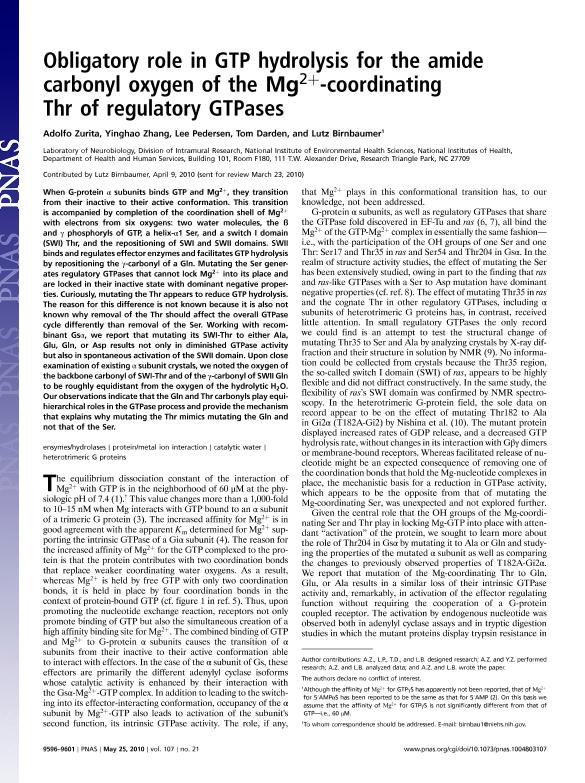Artículo
Obligatory role in GTP hydrolysis for the amide carbonyl oxygen of the Mg2+-coordinating Thr of regulatory GTPases
Fecha de publicación:
25/05/2010
Editorial:
National Academy of Sciences
Revista:
Proceedings of the National Academy of Sciences of The United States of America
ISSN:
0027-8424
Idioma:
Inglés
Tipo de recurso:
Artículo publicado
Clasificación temática:
Resumen
When G-protein α subunits binds GTP and Mg2+, they transition from their inactive to their active conformation. This transition is accompanied by completion of the coordination shell of Mg2+ with electrons from six oxygens: two water molecules, the β and γ phosphoryls of GTP, a helix-α1 Ser, and a switch I domain (SWI) Thr, and the repositioning of SWI and SWII domains. SWII binds and regulates effector enzymes and facilitates GTP hydrolysis by repositioning the γ-carbonyl of a Gln. Mutating the Ser generates regulatory GTPases that cannot lock Mg 2+ into its place and are locked in their inactive state with dominant negative properties. Curiously, mutating the Thr appears to reduce GTP hydrolysis. The reason for this difference is not known because it is also not known why removal of the Thr should affect the overall GTPase cycle differently than removal of the Ser. Working with recombinant Gsα, we report that mutating its SWI-Thr to either Ala, Glu, Gln, or Asp results not only in diminished GTPase activity but also in spontaneous activation of the SWII domain. Upon close examination of existing α subunit crystals, we noted the oxygen of the backbone carbonyl of SWI-Thr and of the γ-carbonyl of SWII Gln to be roughly equidistant from the oxygen of the hydrolytic H 2O. Our observations indicate that the Gln and Thr carbonyls play equihierarchical roles in the GTPase process and provide the mechanism that explains why mutating the Thr mimics mutating the Gln and not that of the Ser.
Archivos asociados
Licencia
Identificadores
Colecciones
Articulos(CCT - CORDOBA)
Articulos de CTRO.CIENTIFICO TECNOL.CONICET - CORDOBA
Articulos de CTRO.CIENTIFICO TECNOL.CONICET - CORDOBA
Citación
Zurita, Adolfo Ramón; Zhang, Yinghao; Pedersen, Lee; Darden, Tom; Birnbaumer, Lutz; Obligatory role in GTP hydrolysis for the amide carbonyl oxygen of the Mg2+-coordinating Thr of regulatory GTPases; National Academy of Sciences; Proceedings of the National Academy of Sciences of The United States of America; 107; 21; 25-5-2010; 9596-9601
Compartir
Altmétricas




